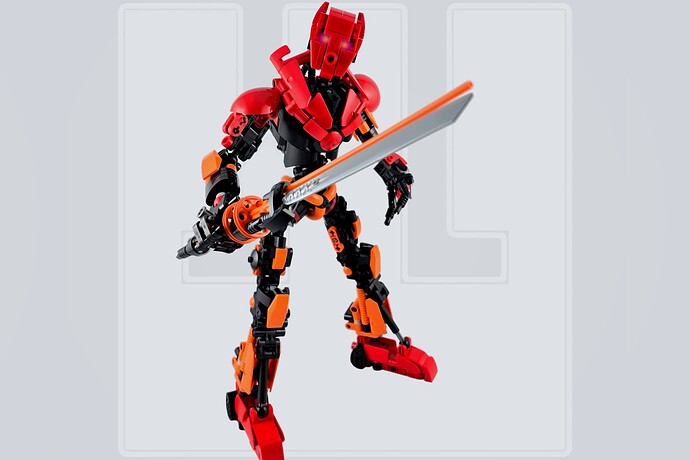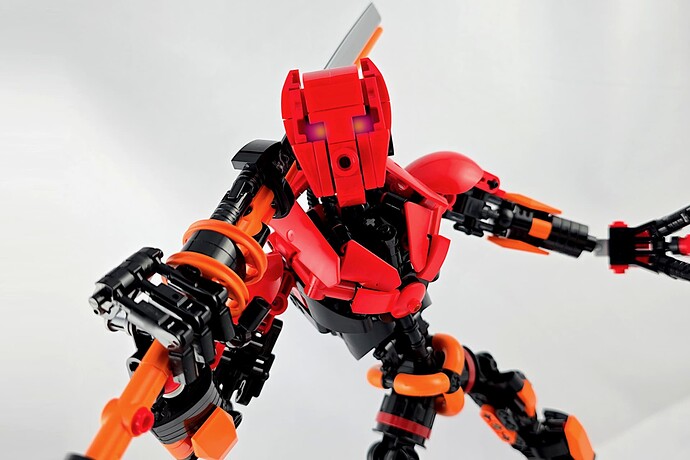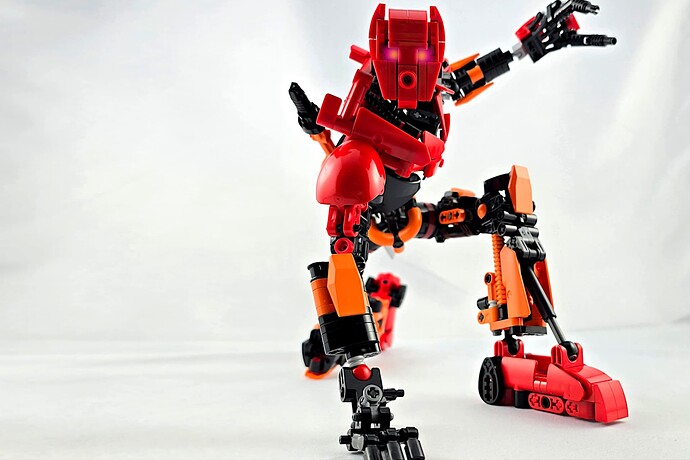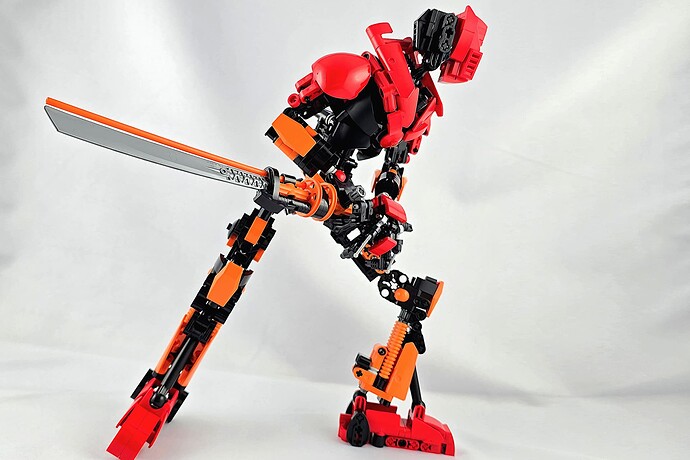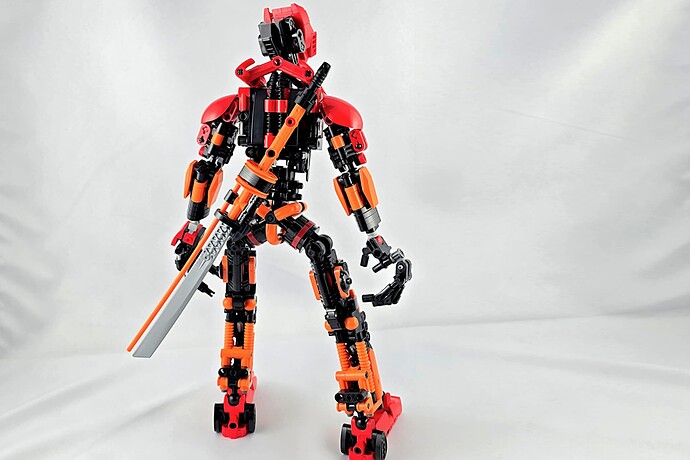Gathered Friends,
The idea behind this project is the fruit of many unrelated conversations with representatives of different age groups. From people who remember the times when you could find canisters with the Robo Riders sets on store shelves, through the generation that spent their childhood playing with Hero Factory figures, to modern LEGO fans who have never had contact with Technic Buildable Action Figures. When talking to these groups, whether in the comments under videos on YouTube, at LEGO exhibitions and during conventions (I even had the opportunity to present my MOCs myself), or simply during random chats with friends and their younger siblings in real life and on the Discord servers, I often took the opportunity to bring up the topic of what a representative of a given generation likes, dislikes, or misses in modern LEGO sets.
Without going into details, I estimated that the project that would best fit what the representatives of the aforementioned groups would like, would be a Character Builder Pack in the style of LEGO Creator 3in1 sets, focused on the theme of buildable robots, but instead of classic bricks offering various types of Technic bricks. After all, among all the currently available sets, there is no single donor of parts, the multiple purchase of which would satisfy the demand of people who enjoy BIONICLE-like MOCs, because you won’t find balljoints, technic panels and armor pieces together in too many sets.
Naturally, such a project would require, in addition to the main course in the form of a huge robot, adding to the project extra bricks in colors other than those used in the main model. For example: allowing to replace the red sections of the building visible above with black, brown, white, green or blue, and orange sections with blue, lime, tan, light gray or dark gray. Unfortunately, showing a pile of scattered bricks in the photo was out of the question and would undoubtedly disqualify my project, due to LEGO Ideas rules, so I had to focus on making the colorful accents an integral part of the MOC, but not overpowering the neutral black base of the structure with them, so that if desired, the buyer could easily modify this design with the bricks they already have.
Originally, I planned to build the MOC in green with lime accents, based on the method of combining colors known from Toa Mata, where the figures were not as monochromatic as Toa Metru, but also not too colorful like the figures from G2, where the characters had too many contrasting colors. Also, I wanted to avoid the same mistake as most sets from Ninjago or Monkie Kid makes: they often have unnecessary and aesthetically ruining gold accents. Unfortunately, it quickly turned out that some of the elements I wanted to use did not appear in the colors I needed, which forced me to change the color palette from green-lime to red-orange.
As a result, the final effect of my work quickly began to resemble Toa Tahu, which was not intended, as I was not trying to create a revamp of the classic set from 2001, but a completely new character who, like the aforementioned Tahu, is a Toa of Fire (although, if it were not for the need to change the color palette, I would probably end up with a MOC resembling Toa Lewa ![]() ).
).
Wanting to distinguish my MOC a bit from Tahu, I had to make sure that his Toa Tool did not resemble a fire sword. Which was not difficult, as the pool of big blade pieces still produced is extremely modest and, in fact, considering that I wanted to avoid using any gold bricks, I had only the katana blade or shuriken to choose from, as these are the only weapons that appear in silver at the moment (according to what I’ve found in Pick a Brick store).
The biggest challenge was of course designing the entire character from head to toe while being limited to the pool of still-produced bricks, because as someone who has been building MOCs with parts from the BIONICLE G1 for over twenty years, I have certain habits that are hard toforget. I gave up on implementing a technic function in favor of appearance and articulation, but after a few minor modifications, I think it wouldn’t be particularly difficult to implement a classic gearbox here. The final result turned out to be a surprisingly stable build. The MOC is hard to tip over, its arms can handle its own weight without any problems, and the torso allows for rotation at the waist and bending in half, while remaining rigid enough for the MOC to remain in the position in which we place it.
Early version of the model had a ball joint connection in the thighs, which made the body proportions more human-like and, interestingly, this solution was enough to prevent the MOC from tipping over under its own weight, but it was not enough to allow it to be set in a more dynamic position, for example with the leg tilted to the side as if performing the kick. Therefore, I slightly disfigured the lower torso section, replacing the ball joint with a ratchet joint introduced in newer mechs. Unfortunately, this brick did not have axle connectors, which would have allowed the hips to be narrowed by a centimeter, but since the element with the rubber insert, introduced for the Toa from G2, is no longer produced, I had no other choice. But figures such as Toa Pohatu Mata have accustomed us to the fact that some Toa can have strange proportions, so adapting the MOC to the new standards presented by modern sets probably did not disfigure the whole thing so much that it would be jarring.
Due to the lack of possibility to implement something as crucial as the canonical Kanohi Mask in the MOC, I decided to invent my own Kanohi. Since I spent dozens of hours delving into the deep lore of G1, I quickly came up with an idea for a power that no canonical mask gave: the power of mental protection. Such a power would fit well into this world, since the series’ lore had many powerful psionics, such as Tren Krom, Artakha or Anona. I inspired the appearance of my mask by the face of Killer Queen from the “JoJo Bizzare Adventures” , but to make it not look too cosmic, I slightly modified the lower half to bring to mind the classic Kanohi Pakari.
Since the MOC is made mostly of Technic bricks, no section of the structure (apart from the custom mask using stud connection) shows a tendency to fall off, I think that even after falling down the stairs, my Toa would remain almost whole.
The MOC reflects the atmosphere of the original sets from the series well, it is not overcomplicated and contains enough diverse parts for everyone to take on the challenge of constructing their own character from the pool of bricks used here. Thanks to this, the set will look good on the shelf if someone decides to assemble it according to the original design, it will develop the imagination of those who buy it for the included parts, and most importantly, it will be a bridge for new generations to get to know the LEGO Technic series, which in recent years has mainly attracted children interested in cars and motors.
At the same time, due to its similarity to Tahu, it will undoubtedly also attract the attention of owners of a copy of the original Kanohi Hau, thanks to which they will be able to turn my Toa into, let’s call it, “Tahu G3”. In fact, if we restored the original Kanohi Hau and Ackar’s sword introduced in 2009 and replaced some of the black bricks with red and orange, my project could become a Toa Tahu UCS set ![]()
Keeping in mind that, next to the Castle, Space and Pirates, only BIONICLE, among the most popular LEGO themes, has not yet received any larger set aimed at collectors, and with the BIONICLE series’ 25th anniversary approaching like the storm, I think that my project could partially satisfy those fans eagerly awaiting for leaks regarding the series’ potential return in Generation 3 form, as it would both provide most of the bricks needed to create their own MOCs, and serve as neat-looking tribute to the series. ![]()
If you like this project and want to support it, here’s the link to its LEGO Ideas page:
Also, check out this link for 360° spin:
~Taohe Netrus~
